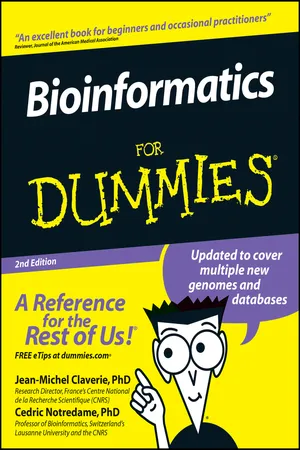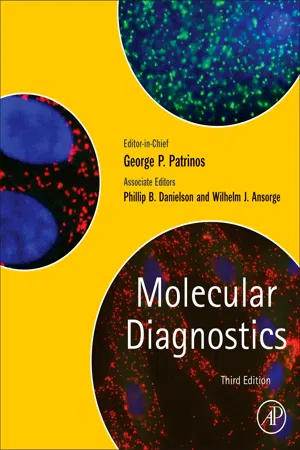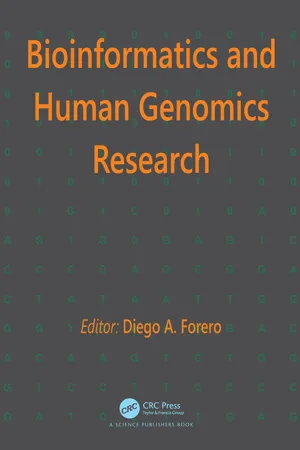Bioinformatics
Bioinformatics is a field that combines biology and computer science to analyze and interpret biological data. It involves the use of computational tools and techniques to understand biological processes, such as DNA sequences, protein structures, and gene expression patterns. Bioinformatics plays a crucial role in areas like genomics, evolutionary biology, and drug discovery.
8 Key excerpts on "Bioinformatics"
- eBook - ePub
- H S Chawla(Author)
- 2011(Publication Date)
- CRC Press(Publisher)
...Thus, Bioinformatics is the marriage of biology and information technology. The discipline encompasses many computational tools and methods used to manage, analyze and manipulate large sets of biological data especially gene and protein sequences. The definition of Bioinformatics and the term itself is not universally agreed upon. Some definitions available in the literature are as follows: 1. Bioinformatics—The science of developing computer databases and algorithms for the purpose of speeding up and enhancing biological research. 2. Bioinformatics—a combination of Computer science, Information Technology and Genetics to determine and analyze genetic information. 3. Bioinformatics—is an integration of mathematical, statistical and computer methods to analyze biological, biochemical and biophysical data. 4. Bioinformatics—can be defined as the storage, manipulation and analysis of biological information via computer science. 5. Bioinformatics—is the science concerned with the development and application of computer hardware and software to the acquisition, storage, analysis and visualization of biological information. The massive amount of sequence data generated by different sequencing projects requires electronic databases to store, organize, and index it. In addition, the databases need specialized tools for scientists to see and analyze the available information, as well as to submit new or revised sequence data...
- eBook - ePub
Bioinformatics Algorithms
Design and Implementation in Python
- Miguel Rocha, Pedro G. Ferreira(Authors)
- 2018(Publication Date)
- Academic Press(Publisher)
...However, this has also raised significant challenges in the management and analysis of such complex and large volumes of data. Biological research has become in many aspects very data-oriented and this has been intricately connected to the ability to handle these huge amounts of data generating novel knowledge, or as Florian Markowetz recently puts it “All biology is computational biology” [108]. Therefore, the value of the sophisticated computational tools that have been developed to address these data processing and analysis has been undeniable. This book is about Bioinformatics, the field that aims to handle these biological data, using computers, and seeking to unravel novel knowledge from raw data. In the next section, we will discuss further what Bioinformatics is, and the different tasks and scientific disciplines that are involved in the field. To close the chapter, we will overview the content of the remaining of the book to help the reader in the task of better navigating it. 1.2 What is Bioinformatics Bioinformatics is a multi-disciplinary field at the intersection of Biology, Computer Science, and Statistics. Naturally, its development has followed the technological advances and research trends in Biology and Information Technologies. Thus, although it is still a young field, it is evolving fast and its scope has been successively redefined. For instance, the National Institute of Health (NIH) defines Bioinformatics in a broad way, as the “research, development, or application of computational tools and approaches for expanding the use of biological, medical, biological, behavioral, or health data” [79]. According to this definition, the tasks involved include data acquisition, storage, archival, analysis, and visualization. Some authors have a more focused definition, which relates Bioinformatics mainly to the study of macromolecules at the cellular level, and emphasize its capability of handling large-scale data [105]...
- eBook - ePub
- Jean-Michel Claverie, Cedric Notredame(Authors)
- 2011(Publication Date)
- For Dummies(Publisher)
...These specialized tasks, taken together, make up the field of Bioinformatics. More specifically, we can define Bioinformatics as the computational branch of molecular biology. Time for a little bit of history. Before the era of Bioinformatics, only two ways of performing biological experiments were available: within a living organism (so-called in vivo) or in an artificial environment (so-called in vitro, from the Latin in glass). Taking the analogy further, we can say that Bioinformatics is in fact in silico biology, from the silicon chips on which microprocessors are built. This new way of doing biology has certainly become very trendy, but don’t think that “trendy” translates into “lightweight” or “flash-in-the-pan.” Bioinformatics goes way beyond trendy — it’s at the center of the most recent developments in biology, such as the deciphering of the human genome (another buzzword), “system biology” (trying to look at the global picture), new biotechnologies, new legal and forensic techniques, as well as the personalized medicine of the future. Because of the centrality of Bioinformatics to cutting-edge developments in molecular biology, people from many different fields have been stumbling across the term in a variety of different contexts. If you’re a biology, medical, or computer science student, a professional in the pharmaceutical industry, a lawyer or a policeman worrying about DNA testing, a consumer concerned about GMOs (Genetically Modified Organisms), or even a NASDAQ investor interested in start-up companies, you’ll already have come across the word Bioinformatics. If you’re good at what you do, you’ll want to know what all the fuss is about. This chapter, then, is for you. Instead of a formal definition that would take hours to cover all the ins and outs of the topic, the best way to get a quick feel for what Bioinformatics — or swimming, for that matter — is all about is to jump right into the water; that’s what we do next...
- eBook - ePub
The Human Genome in Health and Disease
A Story of Four Letters
- Tore Samuelsson(Author)
- 2019(Publication Date)
- Garland Science(Publisher)
...The discipline Bioinformatics has emerged, a discipline that may be defined as the handling and analysis of information originating from current biomedical research. It is an interdisciplinary science with contributions from computer science, mathematics, and biomedicine. Important for the development of Bioinformatics have been researchers who are competent in computer science and/or mathematics and at the same time are appreciating and fully understanding the biological problems addressed. Many of them remain unsung heroes in the history of the human genome as well as in molecular biology in general. But a large number of computational tools have been developed, and many of them have been cited extensively in the scientific literature (Table 12.1). Table 12.1 Selected highly cited scientific publications presenting Bioinformatics methods Publication title Number of citations Publication Basic local alignment search tool 50,967 Altschul, S.F. et al. J Mol Biol, 1990. 215(3): p. 403–10. CLUSTAL-W—improving the sensitivity of progressive multiple sequence alignment through sequence weighting, position-specific gap penalties, and weight matrix choice 48,445 Thompson, J.D., D.G. Higgins, and T.J. Gibson, Nucleic Acids Res, 1994. 22(22): p. 4673–80. Gapped BLAST and PSI-BLAST: A new generation of protein database search programs 46,175 Altschul, S.F. et al., Nucleic Acids Res, 1997. 25(17): p. 3389–402. The neighbor-joining method—A new method for reconstructing phylogenetic trees 39,108 Saitou, N. and M. Nei, Mol Biol Evol, 1987. 4(4): p. 406–25. The CLUSTAL_X windows interface: Flexible strategies for multiple sequence alignment aided by quality analysis tools 29,823 Thompson, J.D. et al., Nucleic Acids Res, 1997. 25(24): p. 4876–82. MEGA5: Molecular evolutionary genetics analysis using maximum likelihood, evolutionary distance, and maximum parsimony methods 28,742 Tamura, K. et al., Mol Biol Evol, 2011. 28(10): p...
- eBook - ePub
Guide to Non-Traditional Careers in Science
A Resource Guide for Pursuing a Non-Traditional Path
- Karen Y. Kreeger(Author)
- 2013(Publication Date)
- Routledge(Publisher)
...6 CHAPTER INFORMATICS An explosion of information in broad areas of science—biomedicine, chemistry, and ecology—is opening new doors for life and physical scientists who have an Interest in computers and the organization of scientific data, as well as computer scientists interested in other areas, for example, genetics and biochemistry. The flood of data from the Human Genome Project and similar efforts, along with technological Innovations in computer databases, has laid the groundwork for the development of Bioinformatics, a burgeoning discipline that involves the collection, management, analysis, and Interpretation of data generated from large-scale genome sequencing databases throughout the world. The need for people trained in computational chemistry, a disciplinary cousin of Bioinformatics and computational biology, has also been growing. Changes in healthcare such as the advent of health maintenance organizations and an ever-increasing number of clinical trials has also led to the expansion of an allied discipline called medical Informatics. This consists of managing the clinical information obtained from drag trials and patient records. While Bioinformatics and medical informatics are where most researchers-turned-informatics-specialists are employed, two other areas warrant close attention for the future. First is the collection, maintenance, distribution, and analysis of Information from scientific journal articles. Once the domain of library scientists, more people with scientific training are being sought for this type of work. One is Marie McVeigh, editor for life sciences at the Institute for Scientific Information (ISI) in Philadelphia. She has a dual В.S. in biophysics and English literature and an M.S. In cell biology from the University of Pennsylvania. “I view my scientific training as an apprenticeship where I learned tools that could apply to other fields,” says McVeigh. “Scientific training is an apprenticeship for doing science...
- eBook - ePub
- Michael Agostino(Author)
- 2012(Publication Date)
- Garland Science(Publisher)
...CHAPTER 1 Introduction to Bioinformatics and Sequence Analysis Key concepts • The scope of Bioinformatics • The origins and growth of DNA databasess • Evidence of evolution from Bioinformatics • Example sequence analysis and displays using human Factor IX 1.1 INTRODUCTION We are witnessing a revolution in biomedical research. Although it has been clear for decades that exploring the genetics of biological systems was crucial to understanding them, it was far too expensive and complex to consider obtaining genetic sequences for that exploration. But now, acquiring genetic sequences is affordable and simple, and data are being generated at unprecedented rates. The heart of understanding all this sequence lies in Bioinformatics sequence analysis, and this book serves as an introduction to this powerful study of DNA, RNA, and protein sequence. Bioinformatics concerns the generation, visualization, analysis, storage, and retrieval of large quantities of biological information. The generation of biomedical data, including DNA sequence, in its raw form does not involve Bioinformatics skills. But in order for that sequence to be usable, it must be analyzed, annotated, and reformatted to be suitable for databases. These are all Bioinformatics activities. Many of these activities can be automated, but their development and support come from someone with skills or experience in Bioinformatics. Once the data have been made available, how do you analyze the data? Is there text like DNA and protein sequence files? If yes, it should be presented in a way to allow interpretation or easy input into programs for analysis...
- eBook - ePub
- George P. Patrinos, Wilhelm Ansorge, Phillip B. Danielson(Authors)
- 2016(Publication Date)
- Academic Press(Publisher)
...Chapter 19 Bioinformatics Tools for Data Analysis L. Koumakis 1, C. Mizzi 2, and G. Potamias 1 1 Foundation for Research and Technology – Hellas (FORTH), Heraklion, Greece 2 University of Malta, Msida, Malta Abstract Next-generation sequencing (NGS) and microarrays have vastly increased the ability to detect sequence variation and gene expression. These technologies require specific Bioinformatics tools to extract information from the raw data. For analyzing human data, NGS pipelines work on three basic tiers: sequence generation, alignment to a reference genome, and interpretation of the results. Various Bioinformatics tools are widely available to analyze NGS data sets specific to target/whole-genome sequencing or RNA-Sequencing. The so-called big data analytics, which have been made possible via high-throughput sequencing, have been vital to systems biology, especially gene regulatory networks (GRNs), which deal with gene-to-gene interactions. Different Bioinformatics tools and pipelines exist for various GRN topics, including gene set analysis and identification of phenotype-differentiating pathways and subpathways with GRN information, topology, and regulatory mechanisms. Keywords Bioinformatics tools; Gene regulatory networks; Gene set analysis; MinePath; Next-generation sequencing pipelines; Phenotype-differentiating pathways 19.1. Introduction High-throughput technologies for gene-expression and sequencing assessment [microarray or next-generation sequencing (NGS)] have vastly improved the ability of life scientists to detect and quantify sequences as well as the expression of genes, proteins, and metabolites. A vast number of Bioinformatics tools have been developed to analyze and extract information from the experimental data...
- eBook - ePub
- Diego A. Forero, Diego A. Forero(Authors)
- 2021(Publication Date)
- CRC Press(Publisher)
...C HAPTER 13 Bioinformatics and Network Analysis of Biological Data Enrique Hernández-Lemus * 1, 2, Hugo Tovar 1, Laura Gómez-Romero 1, Mireya Martínez-García 3 1 Computational Genomics Division, National Institute of Genomic Medicine, Mexico 2 Center for Complexity Sciences, Universidad Nacional Autónoma de México, Mexico 3 Sociomedical Research Unit, National Institute of Cardiology ’Ignacio Chávez’, Mexico * Corresponding author: [email protected] 1 INTRODUCTION Life is a complex phenomenon. This complexity arises at multiple (often disparate) scales and as a consequence of a plethora of elements (genes, proteins, enzymes, metabolites, cells, tissues, organs, organisms, etc.) interacting on entangled and intertwined patterns. Said patterns are often concealed and may result extremely difficult to discern. With the advent of high-throughput, multidimensional experimental techniques in biology and biomedicine, it has been possible to probe simultaneously many (often too many) of these elements at the individual level. However, a theoretical framework is needed to conceptually accommodate and rationalize the deluge of data coming from such exquisite experimental sources (from molecular biology and omic experiments, to electronic health records, other types of clinical data and even social networks information). In view of this, recent advances in network theory come in handy. Network science, was born two and a half decades ago (Barabási, 2003) as a contemporary interpretation (Barabási, 2016) of the well established ideas in mathematical graph theory (Bollabás and Béla, 2001) and its ideas have since then developed into subfields of network biology (Cagney and Emili, 2011 ; Cho et al., 2012) and network medicine (Loscalzo et al., 2017 ; Sonawane et al., 2019). Under this paradigm, it is possible to encompass the myriad of interactions behind biological function within a single (or a few) mathematical object with a well defined structure, namely a network...







